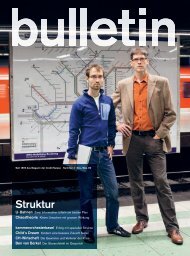Innovation
Global Investor Focus, 02/2007 Credit Suisse
Global Investor Focus, 02/2007
Credit Suisse
Create successful ePaper yourself
Turn your PDF publications into a flip-book with our unique Google optimized e-Paper software.
GLOBAL INVESTOR FOCUS <strong>Innovation</strong> — 42<br />
Chips<br />
TSMC<br />
2330 TT<br />
BUY<br />
Foundries in general and industry leader TSMC<br />
in particular benefit from greater outsourcing by<br />
semiconductor manufacturers.<br />
ASML<br />
ASML NA<br />
HOLD<br />
The ongoing miniaturization of line width in chip<br />
manufacturing requires outstanding lithography<br />
technology. ASML supplies this equipment.<br />
SEZ<br />
SEZN SW<br />
HOLD<br />
SEZ, with its new Esanti product platform, will<br />
benefit from the success of single-wafer technology<br />
in FEOL applications, starting in 2007.<br />
TSMC shows stronger sales growth<br />
%<br />
140<br />
120<br />
100<br />
80<br />
60<br />
40<br />
20<br />
0<br />
–20<br />
–40<br />
TSMC<br />
Global semiconductor sales<br />
98 99 00 01 02 03 04 05 06<br />
Outsourced production in the semiconductor industry<br />
USD million IC Production (ex. memory, analog, MPU)<br />
% of production outsourced<br />
8000<br />
7000<br />
6000<br />
5000<br />
4000<br />
3000<br />
2000<br />
1000<br />
0<br />
Foundry % of IC Production TSMC % of IC Production<br />
60<br />
50<br />
40<br />
30<br />
20<br />
10<br />
0<br />
2Q90 2Q92 2Q94 2Q96 2Q98 2Q00 2Q02 2Q04 2Q06<br />
Until eight years ago, integrated semiconductor companies outsourced<br />
only around 5% of their production to dedicated foundries.<br />
By 2006, this figure had risen to 20% and it will be substantially<br />
higher in five years’ time. At the beginning of the current decade,<br />
a broad shift in strategy became discernible in the semiconductor<br />
industry, away from pro-cyclical investment in capacity expansion<br />
and in favor of increased cost consciousness. Now there are new<br />
factors underpinning the continuation, and even acceleration, of<br />
this outsourcing trend. There has been a sharp increase in the<br />
costs associated with new production plants, a trend which has<br />
prompted integrated semiconductor manufacturers, in particular,<br />
to push ahead with their so-called asset-light strategy (optimizing<br />
existing production combined with outsourcing) in order to<br />
improve both profitability ratios and cash flow.<br />
As a result, sales in the foundry services segment are expected<br />
to expand at approximately twice the rate of those in the<br />
semiconductor industry in the years ahead. This is why Morris<br />
Chang, founder of the dedicated Taiwanese semiconductor foundry<br />
TSMC, predicts that foundries will account for around 40% of<br />
total semiconductor production in coming years. However, this is<br />
not the only good news for foundries. Integrated semiconductor<br />
manufacturers such as Infineon Technologies, Texas Instruments,<br />
Freescale and NXP (formerly Philips Semiconductors) are planning<br />
to outsource all or part of their process technology to foundries<br />
in order to devote themselves exclusively to chip design.<br />
Even though the demands being made on the foundries are growing,<br />
this additional service provides them with the opportunity to<br />
command higher prices from their customers. Given the resultant<br />
economies of scale, the concentration of production activities at<br />
foundries also appears attractive from a cost viewpoint.<br />
At TSMC, so-called gigafabs are already either at the planning<br />
stage or under construction. The aim of these supersized<br />
foundries is not only to create substantial cost advantages relative<br />
to smaller production units, but also to increase the quality of<br />
production and to shorten timetomarket. This last factor will be<br />
of particular importance in future. On the back of this trend, the<br />
technological leadership of foundry services companies will continue<br />
to be enhanced. Naturally, this will require a sufficient level<br />
of investment in new production facilities. Although, in turn, this<br />
will lead to increased dependency on foundries on the part of<br />
semiconductor equipment suppliers, it will also make it possible for<br />
the latter to introduce new production equipment far more rapidly<br />
and in larger volumes.<br />
TSMC’s technological leadership is based, to a significant extent,<br />
on the company’s close cooperation with ASML, the world’s<br />
leading provider of lithography systems. Developments within this<br />
product segment are decisive in terms of the ongoing miniaturization<br />
of line widths in chip manufacturing, which is critical for containing<br />
costs. At the same time, however, this ongoing miniaturization<br />
places high demands on the purity and thus the preservation<br />
of chip functionality. In this regard, the structure of cleaning systems<br />
is undergoing a process of change. Smaller line widths, in<br />
particular the transition from 65- to 45-nanometer chips, can be<br />
expected to result in increased demand for single-wafer cleaning<br />
systems. The Austrian manufacturer SEZ boasts a product portfolio<br />
that in future will be capable of targeting the entire market for<br />
wet chemical cleaning systems.<br />
Given that foundries are among their most important customers,<br />
the manufacturers of lithography systems and single-wafer<br />
cleaning systems are currently benefiting from the trend toward<br />
smaller line widths and from the foundries’ anticipated relatively<br />
high production volumes. In our view TSMC, ASML and SEZ will<br />
be the main beneficiaries for the continuing acceleration and miniaturization<br />
trend. Ulrich Kaiser<br />
Source: TSMC, SIA, Credit Suisse, UMC, Chartered Semiconductor, SMIC

















